Sylvain Pinaud Origine: How Do We Define A Beginning?
Origins are an interesting topic to consider because they purport to explain what truly started it all. You could say that the origin of the current Marvel Cinematic Universe is the original Iron Man movie, but that would be forgetting the earlier Marvel movies that have retroactively been made cannon by inclusion in recent films, and whose success made the MCU a possibility. That further obscures the fact that there is decades of source material that have provided a foundation for the films and Kevin Feige’s ideas for his version of them.
But like with any origin story, comic or otherwise, there is always a history stretching far beyond the obvious that plays a role in creating the present. Stories of heroes throughout the centuries, Greek and Roman myths, the epics of Homer and Gilgamesh, and countless forgotten tales of bravery in battles between good and evil, all form the literary and emotional framework that modern superhero stories are built around. The same analysis can be applied to almost any topic or idea.
We only imagine life on Mars and other planets in science fiction because science allowed us to understand that planets weren’t, as the Latin name suggests, wandering stars, but solid places that we could inhabit given the right circumstances and technology. But even with that, the only reason that science gave us that understanding is because of much earlier desires to understand how our world worked and that people that developed a method for doing so. Therefore, you could justifiably claim that the origin of Elon Musk’s desire to colonize Mars and the work of SpaceX lies far in the past with thinkers and philosophers lost to time.
It also demonstrates the somewhat philosophical futility of defining origins because we always draw arbitrary lines to exclude earlier events. If we wanted to be pedantic, we could argue that the origin of anything is the beginning of the universe, but while semantically correct, it is also woefully unsatisfying. The origin should be at least clearly related and thematically coherent, the butterfly effect need not apply. We also don’t have to go back to any true beginnings to define an origin because a meaningful starting point is as personal as we make it, it’s our choice.
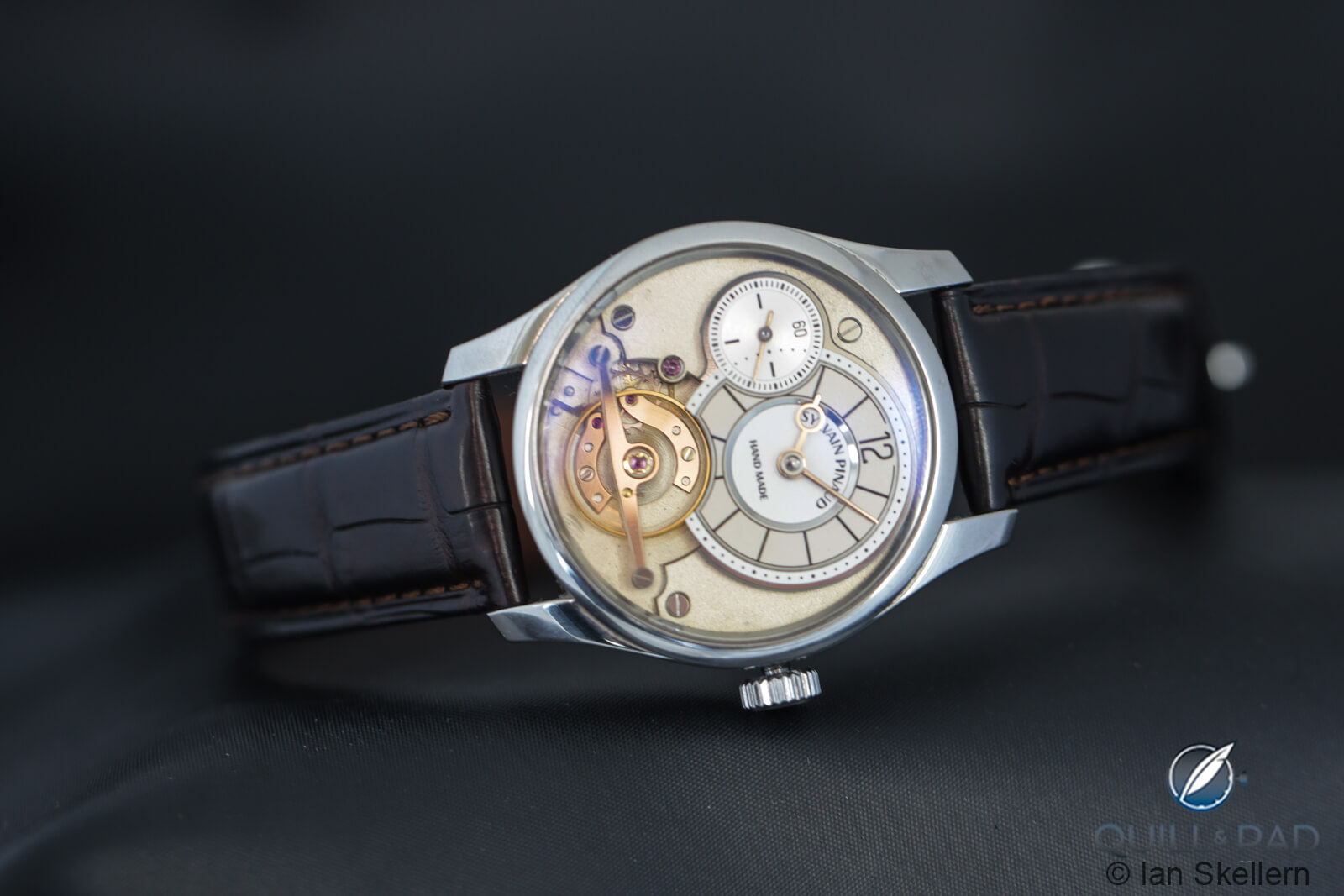
Sylvain Pinaud Origine
So, when independent watchmaker Sylvain Pinaud created a new watch based on the idea of horological tradition and heritage, it was up to him to define what that meant and where it began. Fittingly he named his watch Origine, and by doing so we can clearly see where he decided it all started.
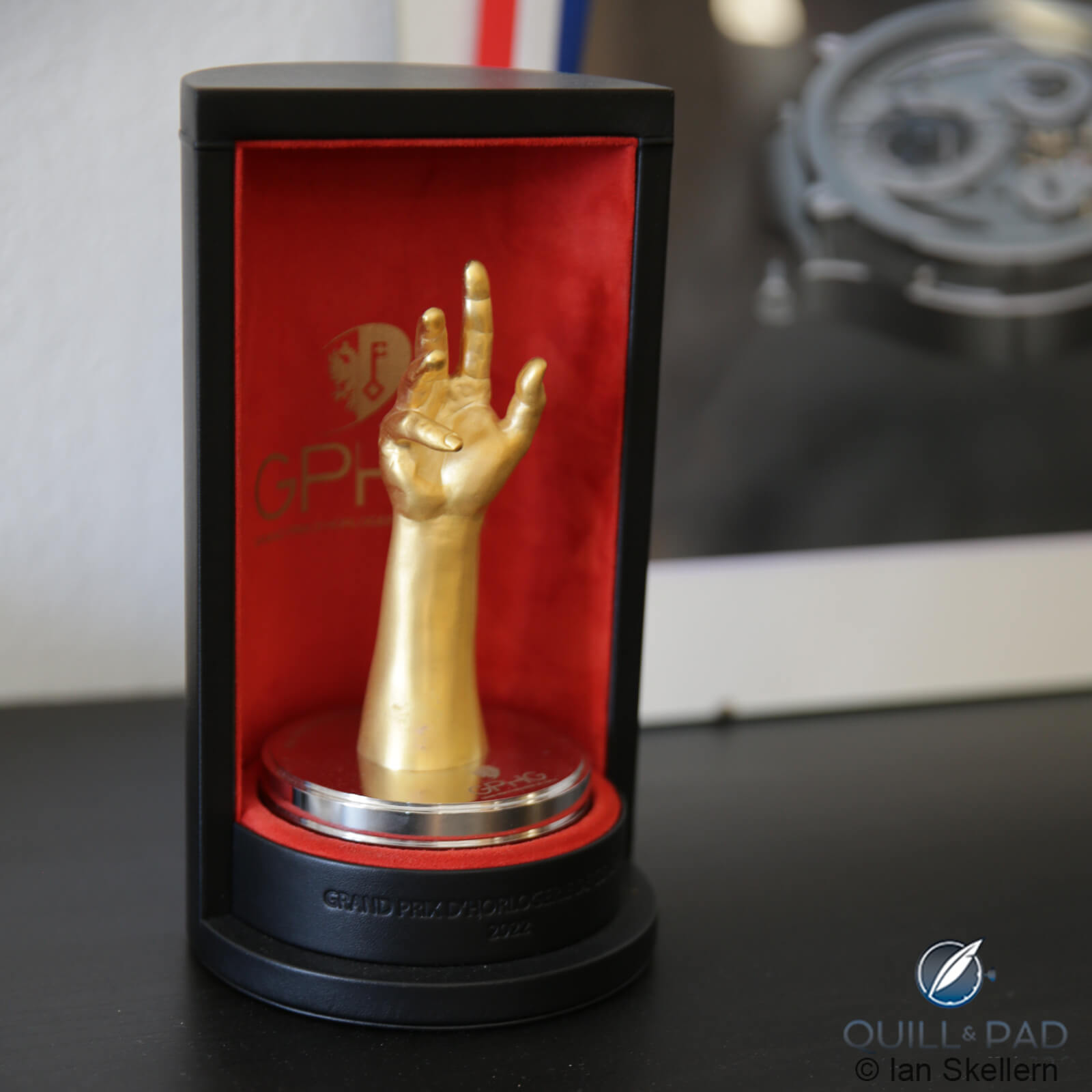
Sylvain Pinaud’s trophy for the Revelation Prize at the 2022 GPHG
And Pinaud’s approach appears to have been successful as he was awarded the Revelation Prize at the 2022 Grand Prix d’Horlogerie de Genève (GPHG).
Sylvain Pinaud Origine
As one might expect, Origine is an essentially simple watch telling only the time with three hands. The hours and minutes are displayed on a main dial, while the seconds are indicated on a subsidiary dial, typically a rather classic configuration, but here are set side by side on the upper half of the dial.
The movement is a very traditional three-quarter plate design, with the twist being that the balance and escapement have migrated to the front of the watch to highlight Pinaud’s watchmaking prowess.
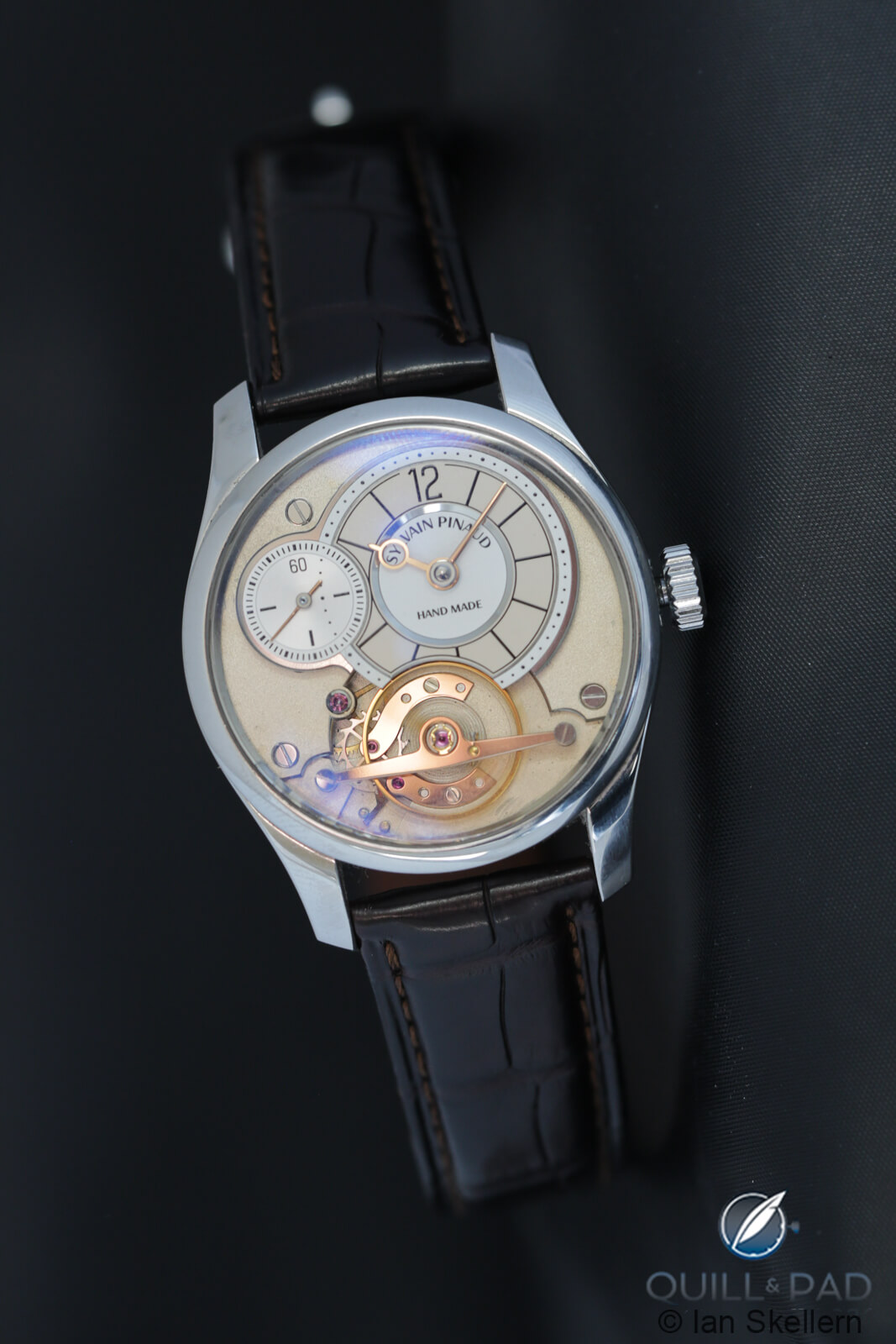
Sylvain Pinaud Origine
The dial is modern while all the finishing and materials are fairly traditional, keeping Origine from feeling trapped in any specific time period.
Made mostly in-house, the hand-wound movement displays a variety of inspirations from the current industry and from history, blurring the lines of any true origin for the concept. Like I said, Pinaud was able to define his origin and it appears that he did not limit himself in time but instead in application. The dial and case are made by Comblémine, owned by Kari Voutilainen, and they display attention to visual proportion and legibility, something every young independent watchmaker must master to truly make their mark on the industry.
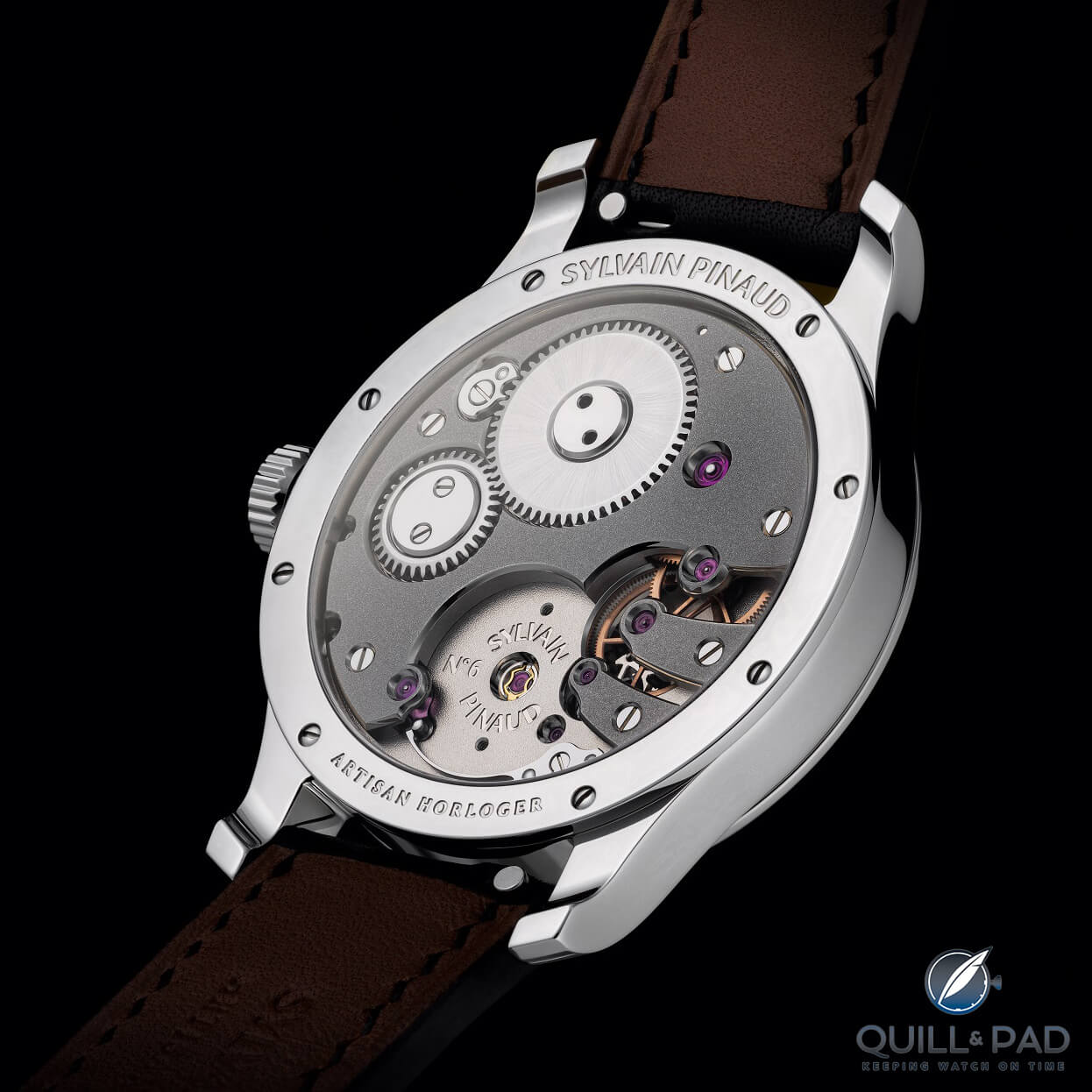
Back of the Sylvain Pinaud Origine
That same attention to detail is seen on the rear of the movement with an asymmetrically balanced layout, a mainspring barrel and winding wheel balancing the cutouts for the gear train and balance support. The support for the escape wheel and fourth wheel have taken the form of finger style bridges, an absolute favorite of mine that has seen dozens of iterations on various movements, and are always an architectural highlight. While simple, the finishing is completed to an extremely high level, meeting even the most discerning collectors’ high standards.
Multiple inward angles are found on the plates, and the surfaces have all been expertly attended to, achieving a variety of pristine finishes. But the most visually intriguing aspect is the balance and escapement on the front of the dial. It adds a ton of depth to the face, especially combined with the raised dial sections and the large flat polished balance bridge spanning almost the entire lower half of the dial. The contrast is high with a very monochromatic aesthetic, the only touches of color being the blued hands and the jewels mounted in the base plate, or on the gold version, the hands, balance bridge, and pallet lever support.
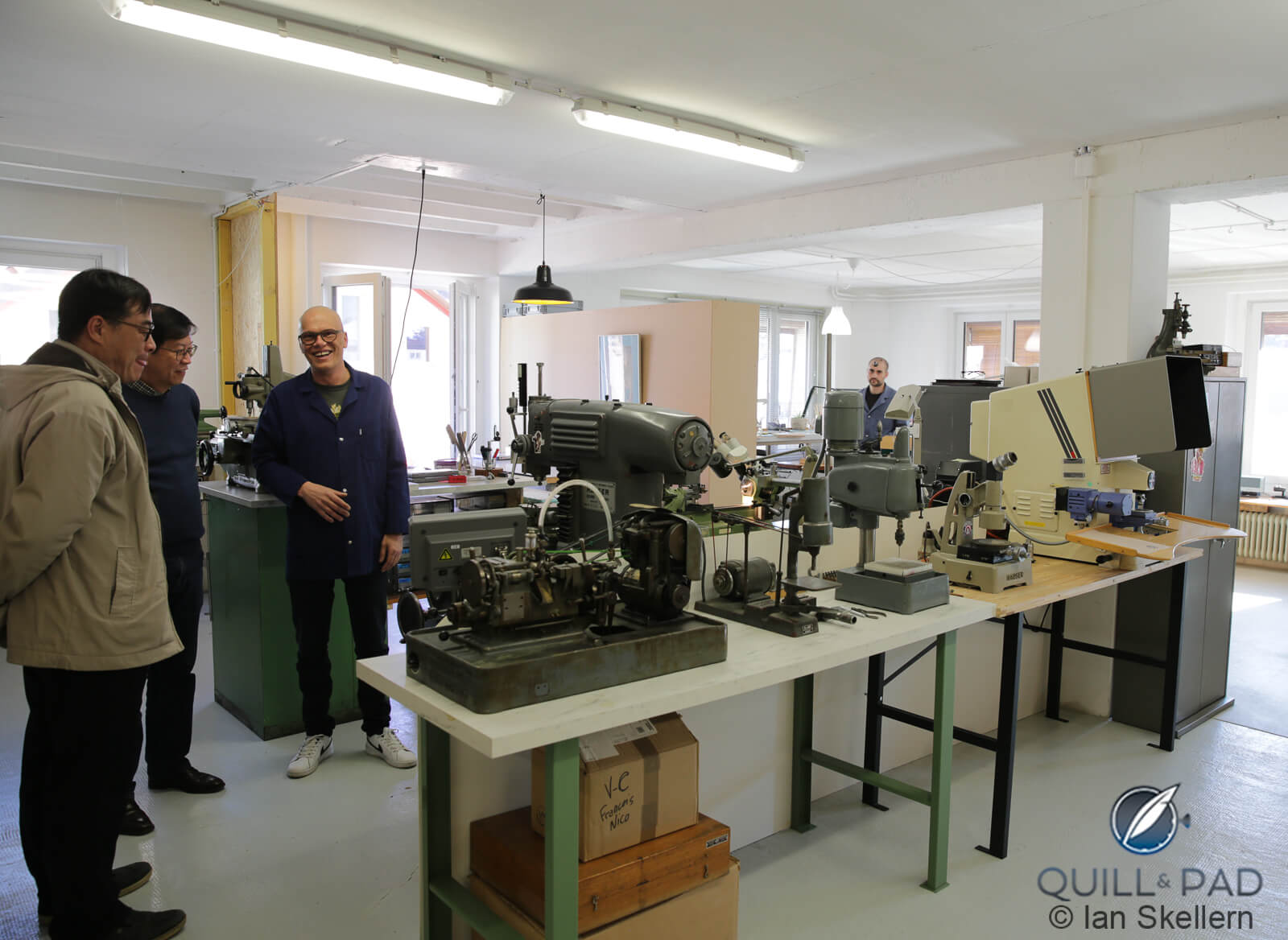
Sylvain Pinaud (white shoes) welcoming collectors to his well-equipped workshop in Sainte-Croix, Switzerland
Tradition can be anything you decide
There aren’t screwed gold chatons like you might find in some very classically styled pieces, yet the movement plates and bridges are made from German silver, a classic material with a subtle warm hue. The balance wheel isn’t the classic pocket watch style boasting tiny, screwed weights but a more modern three-arm shape with three gold timing weights, and it beats at a slightly faster 21,600 vph (3 Hz) compared to the very traditional 18,000 vph (2.5 Hz).
Both could be considered traditional compared to the even more modern 5 Hz silicon balances with silicon hairsprings and escapements that are laser adjusted, so it’s all about perspective. This is what I mean when I say that Pinaud chose tradition in a way that made sense in his own context. He prioritized making a movement with traditional materials (metal hairsprings, German silver, steel, and gold) and avoided things that could make it more difficult to service by the average independent watchmaker.
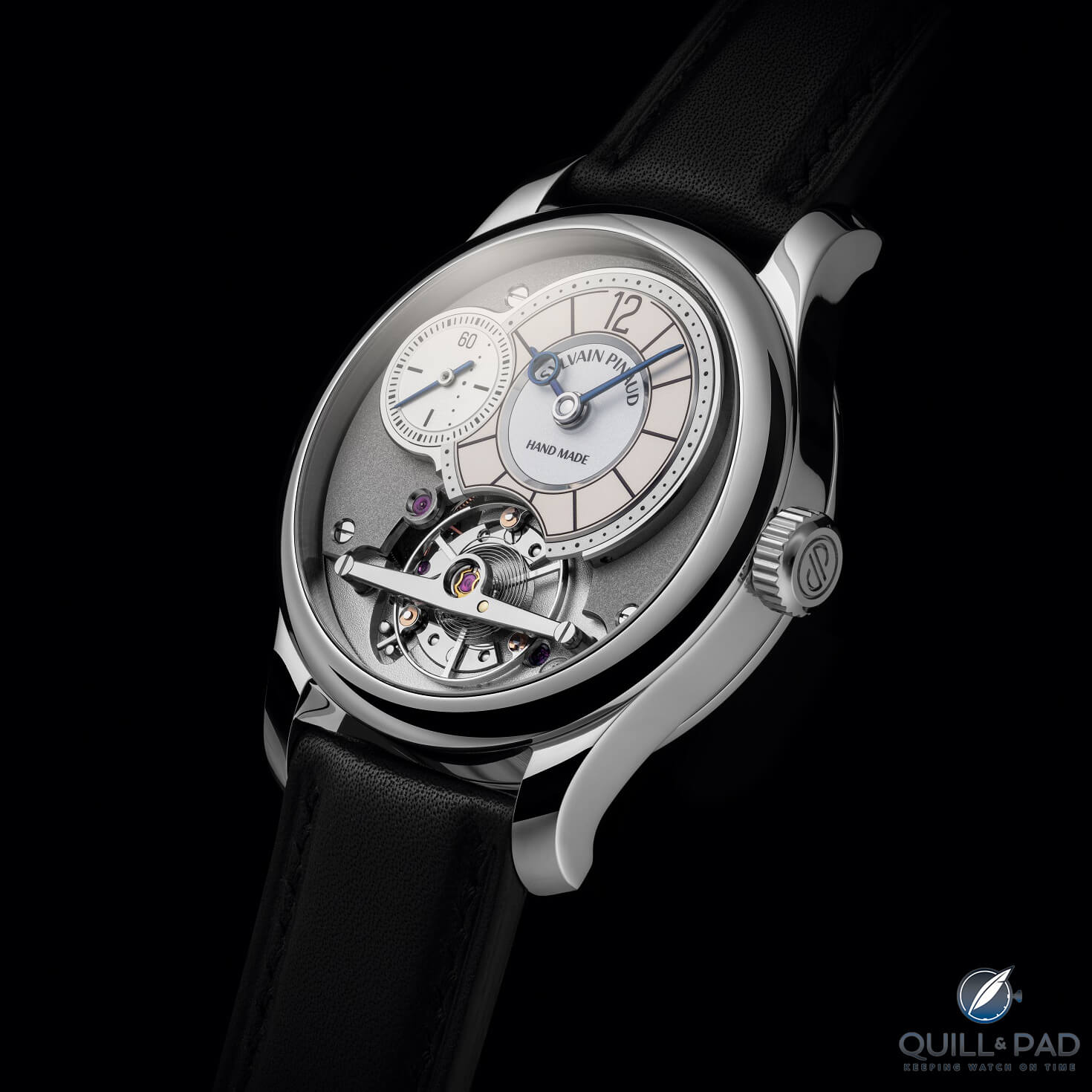
Sylvain Pinaud Origine
Not seen is an attempt to be as traditional as possible in execution, like something Roger W. Smith might create, because that is a very narrow definition of tradition. Much of Origine is still made and finished by hand, but it was designed using CAD and some CNC was used as necessary. It incorporates modern shock protection for the balance but could easily be handed to a watchmaker from the 1920s and they would find it familiar and easy to service. The design of the dial and the layout of the movement is definitely inspired both by historic calibers from previous centuries as well as modern movements from the likes of Greubel Forsey.
It is a hand wound movement which is to be expected from these types of watches, yet it features hacking seconds, a feature that is very non-traditional in the full scope of horological history but is an important update for precision watches. Origine was intended to be a precise timepiece, built with a free-sprung balance and Phillips terminal curve for exacting regulation, the inclusion of hacking seconds is a fantastic update to a classic movement.
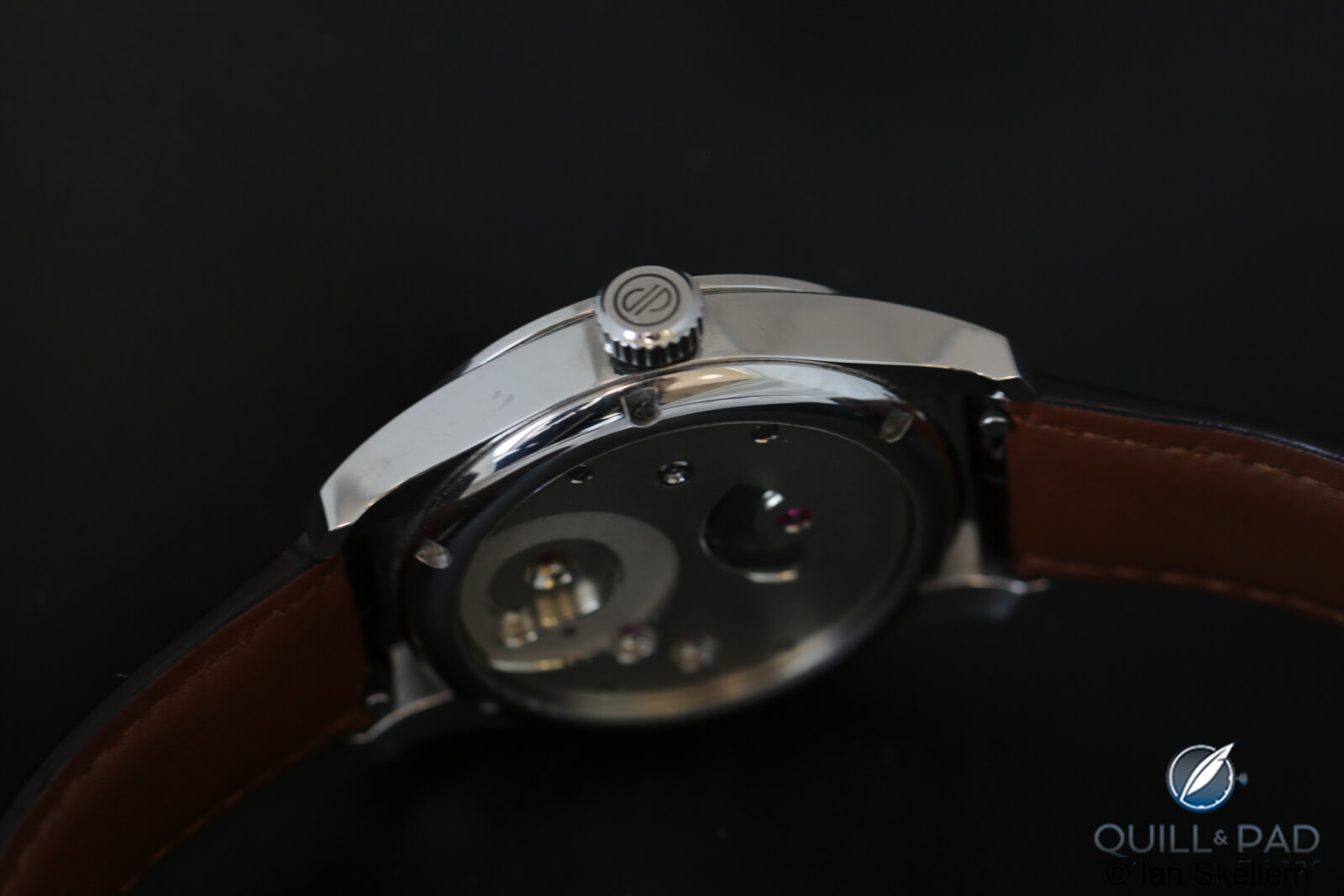
Sylvain Pinaud Origine caseband and crown
A collage of details
These differing inclusions of very old and more modern techniques demonstrate that a respect and admiration for tradition does not require limiting yourself to only what was done two hundred years ago. It might be traditional, but it was only done that way because it was the best at the time. Every watchmaker chasing chronometric performance in 1820 would have jumped at the chance to make updates that are found in watches from 1920 and 2020. They weren’t going to hold to tradition as they were pushing the boundaries of horology just for tradition’s sake, it needed to make sense.
Hence why Sylvain Pinaud made a collage of “traditional” decisions from different eras of watchmaking, it was all in service of making a great watch. The most modern techniques for producing the regulator assembly are restricted to large budgets, high tech equipment, and specialized tools, while traditional materials incorporating modern designs and methods give a broad range of accessibility for watchmakers and collectors.
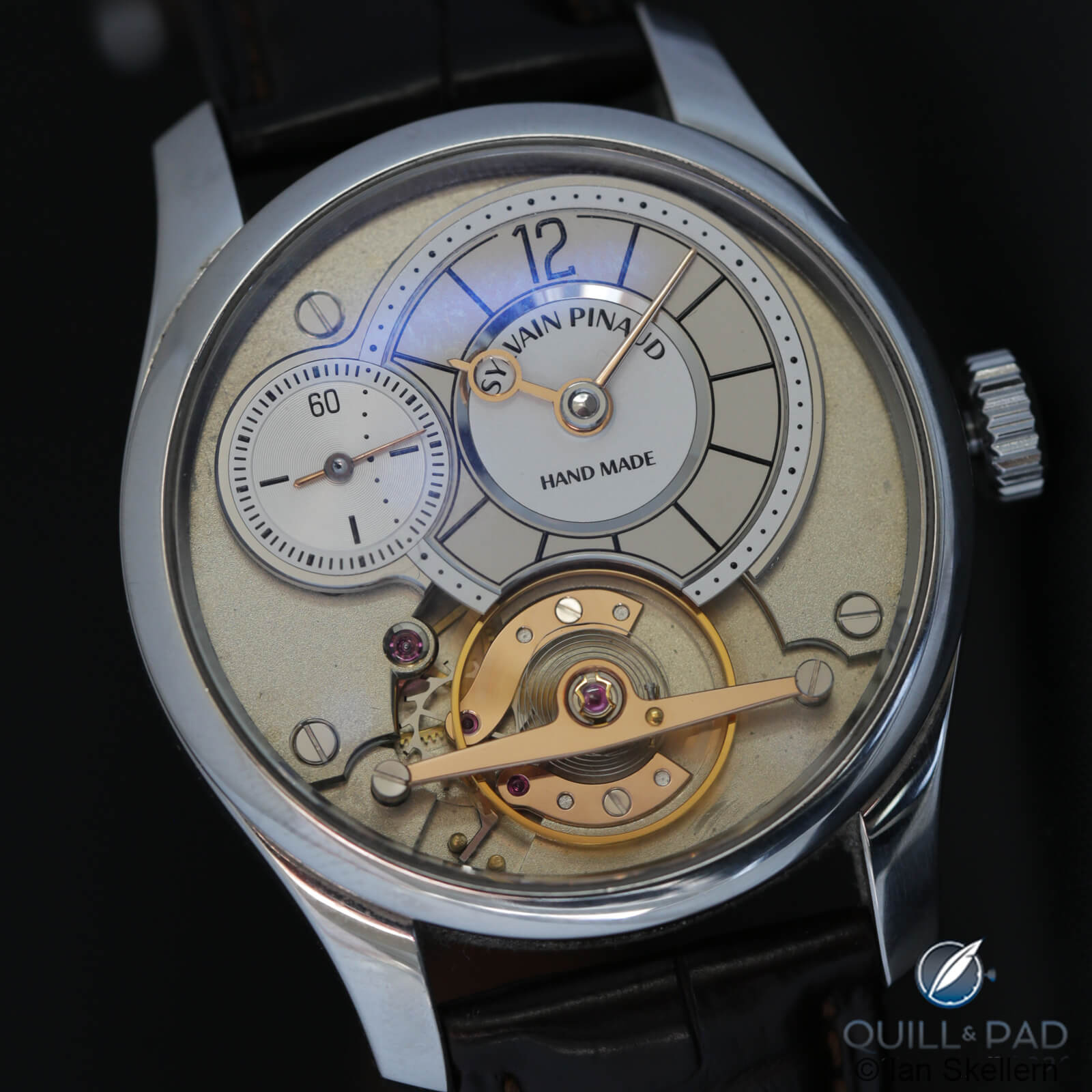
Sylvain Pinaud Origine
A quality watchmaker should be able to create a new wheel or shape a new hairspring for the Origine if required, and that makes the watch much more robust for a collector. Some of my absolute favorite watches ever created are a major headache for future repairs which keeps many collectors from taking the plunge. This can even be seen in resale values, watches that are guaranteed to be serviceable from a stable, long enduring brand or a small watchmaker that creates a piece any watchmaker could work on will maintain higher values long term. Something built on experimental techniques like the Girard-Perregaux Constant Escapement, not so much (still iconic though).
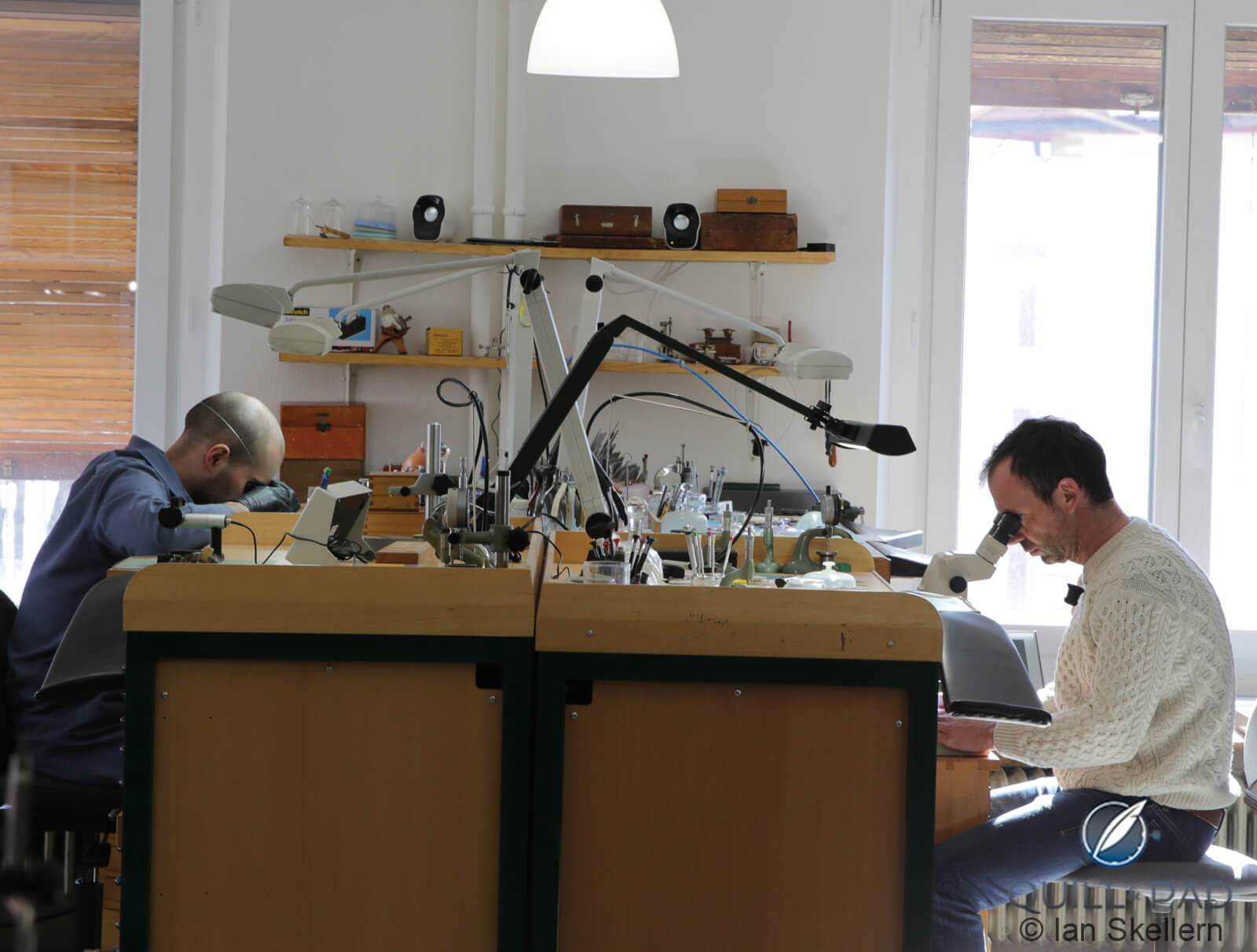
Watchmakers at the bench is Sylvain Pinaud’s atelier
That is why I think the Sylvain Pinaud Origine will find a lot of happy collectors wanting to get on board his train, he clearly understands how to make a watch that fits a collector’s mindset perfectly. Mix some of the best features of new and old into a visually interesting watch that isn’t just another Nautilus wannabe. Learn from the best in the business, and for the case and dial, work with the best in the business.
From the first watch Sylvain Pinaud launched to the second (a chronograph), he has shown a tremendous amount of growth as a brand, not just as a talented watchmaker (which he always was). The design and execution of Origine demonstrate that a solid future can be expected from the brand, thanks to the small and dedicated team. The commitment to execution puts him on a level with some of the greats and is a good indicator that we will see a lot more from this burgeoning young brand.
While you consider what might come next, let’s break this down!
- Wowza Factor *9.2 The interesting layout, high quality finishing, and awesome mix of different horological traditions blends together for a presentation that makes any collector say wowza!
- Late Night Lust Appeal * 92 » 902.212m/s2 Simple watches can be surprisingly easy to lust after all night, and this one is no exception!
- M.G.R. * 62.8 The classic nature of the movement mixed with excellent finishing and a visual impact that feels distantly related to other impressive watches makes this a rather geeky movement!
- Added-Functionitis * N/A Once again we can skip the Gotta-HAVE-That cream and just enjoy the simplicity of a time only watch that doesn’t try to be anything else!
- Ouch Outline * 9.6 Developing a sore from bad shoes! Sometimes it is simply a poorly designed or chosen insert, but it’s easy to have a very painful walk if your feet start to get injured over time. But I’d gladly walk 100 miles in bad shoes if it means getting the Origine on my wrist!
- Mermaid Moment * A week on the wrist! Discounting those that knew it was for them, the Origine could fly under the radar until you wear it enough to understand just how awesomely it serves its purpose as a dedicated timepiece!
- Awesome Total * 825 Start with the hours of power reserve (55) and multiply by the water resistance in meters (30), then divide by the number of versions there are (2) for a simply awesome total!
For more information, please visit www.sylvain-pinaud.com/origine/.
Quick Facts Sylvain Pinaud Origine
Case: 40 x 11 mm, stainless steel
Movement: manually wound Origine caliber, 55-hour power reserve, 21,600 vph/3Hz
Functions: Hours, minutes, seconds
Price: CHF 65,000 with steel hands, CHF 68,000 with gold hands and bridges



Leave a Reply
Want to join the discussion?Feel free to contribute!